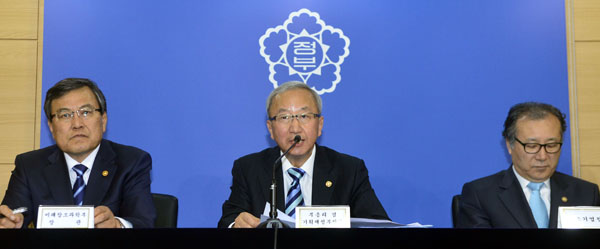Chasing the start-up dream has a history

Minister of Science, ICT and Future Planning Choi Moon-kee, left, and Hyun Oh-seok, deputy prime minister for economy, center, announce the government’s plan to boost investments in start-ups at a press conference held at the Central Government Complex in Gwanghwamun, central Seoul, yesterday. [NEWSIS]
But this is not the first time a new government has come up with grand blueprint to aid budding businesses, venture capital companies and so-called angel investors. Some over the past 15 years ended up as slogans with no substance.
In the early stage of the previous Lee Myung-bak administration, for instance, new policies to reduce financial support for established companies and give a boost to start-ups were announced.
They were blown away when the global financial crisis hit the country soon after Lee’s inauguration and larger firms opposed them.
It was during the Kim Dae-jung administration from 1998 to 2003 that a government-led drive to support start-ups most concretely materialized. It triggered the recovery of the domestic economy from the 1997-98 Asian Financial Crisis, called the IMF Crisis locally.
On the back of the government’s unprecedentedly strong support - largely by indiscriminately designating start-ups as worthy of support - capital that was floating around in the market in search of a proper investment destination quickly attached itself to start-ups, most of them listed on the secondary Kosdaq exchange.
Since government financial aid kicked in immediately after a company registered itself as a start-up, a number of unqualified companies were born.
The amount of capital that went to start-ups in 1999 more than doubled in just a year to 2.2 trillion won ($1.9 billion).
The Kosdaq peaked at 283.44 - 2,834.4 when translated to the current, revised system - in March 2000.
But the market collapsed later that year in tandem with the burst of the dot-com bubble in the United States, dealing a mega-blow to private investors. The Kosdaq nosedived to as low as 52.58 at the end of 2000.
Amid concerns over the repeat of the same error, Minister of Science, ICT and Future Planning Choi Moon-kee stressed in front of reporters yesterday that “this time would be different.” Hyun Oh-seok, deputy prime minister for the economy and finance minister, said the same thing earlier in the day.
“The focus of the government policies was on loans for start-ups during the Kim Dae-jung administration,” Choi said. “Once a company started showing signs of collapsing, hardly anyone would acquire it. We will encourage angel funds to take the role and push ahead with [a collapsing firm’s] merger and acquisition or reception of funds from overseas investors.”
Analysts said the government should scrutinize the process of selecting start-ups to receive support.
“Venture capital firms that serve as angel investors in the United States normally provide start-ups with financial and marketing assistance,” said Park Jae-hwan, president of the industry and start-up management graduate school at Chung-Ang University.
“In Korea, by contrast, angel investors in the majority of cases simply give out cash and rarely go beyond that level.”
The professor said venture capitalists should be encouraged by the government to get involved in management of the start-ups they invest in. That way, investors in start-ups can minimize potential damage from failure of the business.
By Seo Ji-eun, Kwon Hyuk-joo [spring@joongang.co.kr]










with the Korea JoongAng Daily
To write comments, please log in to one of the accounts.
Standards Board Policy (0/250자)